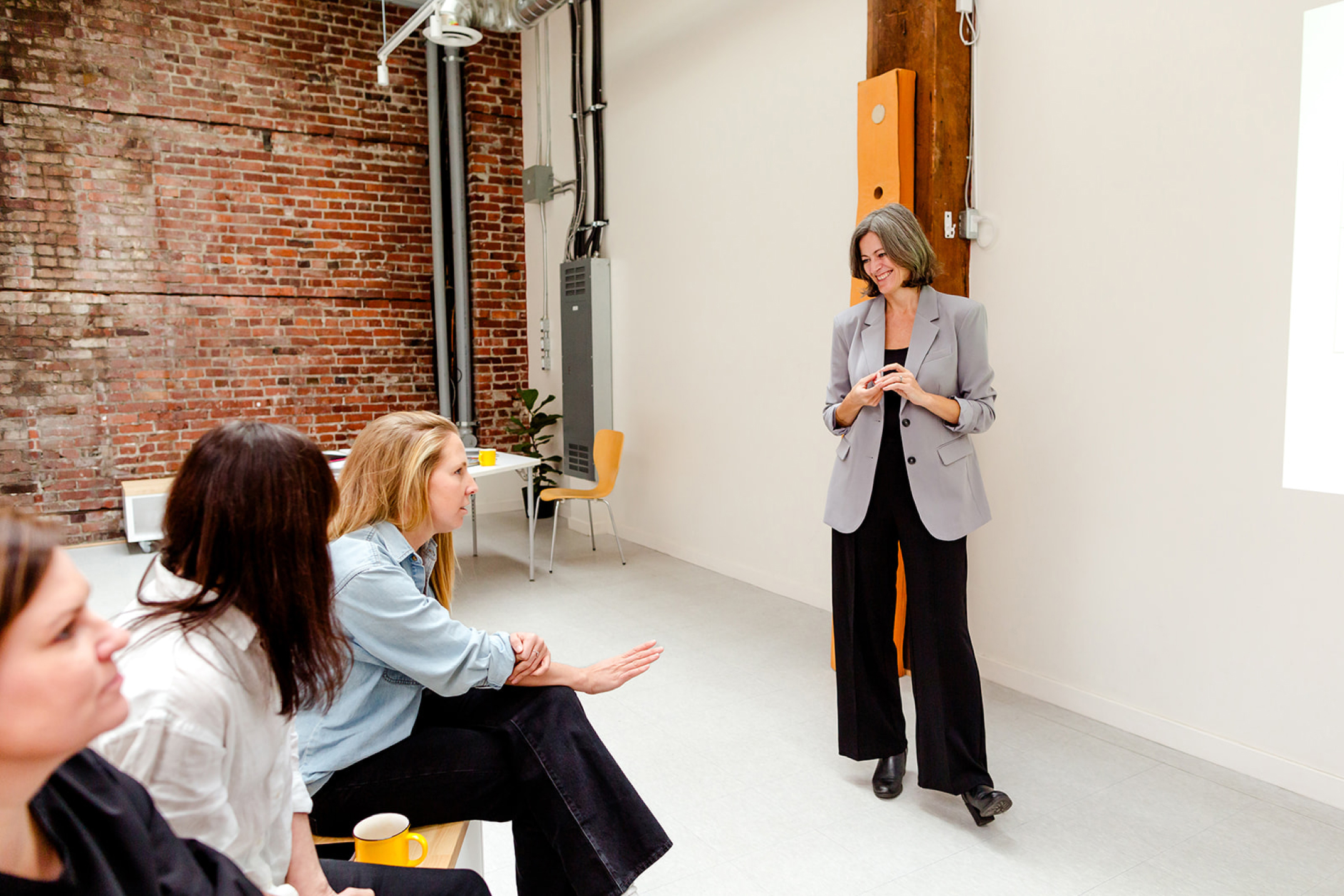Feel, Know, Believe: The Framework That Turns Your Foundational Messaging Into Action
I often talk about why having a clear content marketing mission matters—and I wrote recently about how it became our north star at Forge & Spark when we realized our own content wasn’t reflecting who we’d become. But here’s the thing: even the best content marketing mission statement is just a well-worded paragraph unless you have a way to bring it to life.
And that’s where so many brands get stuck. Maybe you’ve nailed your branding and messaging—your content mission, your core brand message, your unique point of view, maybe even specific messaging for products and services, and your brand voice and tone guidelines. But then what? How do you turn those important words into content marketing that actually builds relationships, sparks trust, and drives results?
Ultimately, all of that is just foundational unless you have a system for activating it through the content you actually create.
That’s where the Feel, Know, Believe framework comes in.
Here’s What I Know About Content That Misses the Mark
I’ll be honest: I’ve seen way too many jam-packed content plans and calendars that don’t actually accomplish much. Hell, I’ve created a lot of that kind of content myself when I’m busy, or rushing to ‘just get that post out there.’
You know that content: it’s blogs and social posts that sound good in theory, hitting all the trendy formats, and lining up with what everyone else seems to be doing… but at the end of the day, they don’t drive actual business results, build genuine relationships with audiences, or make people feel much of anything.
Does that sound familiar to you, too?
In my experience, the problem usually isn’t the quality of the content itself. It’s the lack of what I’d call productive intentionality behind it. When there’s no clear purpose driving each piece of content, you’re basically just adding to the general noise out there.
It’s what I call throwing up content because you’re told you should. And it doesn’t work because often you’re just hitting your audience with random thoughts, rather than thinking about how they encounter you, what they initially like about you, or what resonates, what makes them trust you enough to consider buying from or working with you, and what genuinely makes them want to stick around in your audience, community, or client base.
Think about how you build trust with a new friend. You don’t lead with your deepest values or biggest asks, right? You start with something relatable—a shared experience, a common frustration, that moment when you both realize you “get” each other. Then, as trust builds, you share more of who you are and what you stand for. Eventually, maybe, you make an ask that leads to deeper connection or action.
Your content should work the same way.
The Feel, Know, Believe Framework: Your Content Journey Map
The Feel, Know, Believe framework helps you take your foundational messaging and turn it into content that moves people through a natural progression—from initial awareness to deep trust to enthusiastic advocacy. All rooted in your purpose, values, and messaging that feels authentically you.
It’s the bridge between knowing what you stand for and creating content that actually reflects those values while building real relationships.
And here’s what I love about it: it’s simple. After years of wrestling with infinitely complex journey maps and intersecting content pillars and format matrices (good gravy, the spreadsheets I’ve created!), I’ve learned that the best frameworks are the ones you can actually remember and use consistently.
Here’s how it works:
FEEL Content gets their attention and makes them like and relate to you
KNOW Content allows audiences to logically understand what you do and sell
BELIEVE Content creates advocates who trust not just what you do, but why you do it
Let me break down each stage and what it looks like in practice.
FEEL content is your demand generation—it makes people realize they need something you’ve got. KNOW content is where conversion happens—it gives them the logical understanding they need to buy from you. BELIEVE content is all about retention—turning customers into advocates who stick around and refer others.

FEEL Content: Make People Stop and Say “Yes! Someone Gets It!”
FEEL content is your awareness stage—the stuff that makes people pause mid-scroll and think, “Exactly!” or “I’ve never thought about it that way, but that’s so true.” This is where you create demand for what you offer by making people feel like they need something from you specifically.
I was reminded of this recently at a lunch for my son’s basketball team at White Spot. As an introvert, these group social situations aren’t exactly my forte. But I’ve learned that if I can find a point of connection with someone, it makes the whole experience infinitely more enjoyable.
So there I was, making small talk with other parents, when I discovered that one of the dads was a musician my brother used to hang around with back in the day. (Hi Rich, hope you’re well!) Suddenly, we were swapping stories about that whole scene, talking guitars, and pulling other music-loving parents into the conversation. What started as an obligatory parenting event turned into a genuinely fun experience.
What always strikes me in these situations is watching people’s faces light up when we find those points of connection—shared experiences, mutual curiosities, common ground. That spark of recognition, that moment of “Oh, you get it” or “That’s so interesting, tell me more.”
That’s exactly what’s behind FEEL content. It’s about creating those moments of recognition and curiosity that make people want to stay in the conversation.
This isn’t about being provocative for the sake of it. It’s about having a clear point of view that resonates with your ideal audience while naturally filtering out people who aren’t a good fit.
What FEEL content does:
- Highlights a common frustration or challenge your audience faces
- Shares a fresh perspective on something they think they already understand
- Makes them feel seen and less alone in their struggles
- Establishes you as someone who “gets” their world
- Creates demand by making them realize they need what you offer
Examples of FEEL content:
- A newly certified B Corp sharing why traditional business metrics feel incomplete when measuring impact
- A founder’s story about the moment they realized something specific about their industry (something that isn’t commonly acknowledged) / their ‘hot take’ on why things are the way they are
- A nonprofit leader’s honest post about donor fatigue (through a lens donors will relate to)
- Maybe an eco-friendly brand calling out greenwashing in their industry … and maybe even how they’re evaluating their own public statements (something that shows self-analysis, vulnerability, honest self-assessment)
- A women-led consulting firm discussing why “culture fit” often excludes the voices organizations need most
How you’ll know this kind of content is working: People share it. They engage in conversation, saying things like “I’ve felt this too.” They tag colleagues. They comment with their own stories. Your reach grows organically, and you start attracting new followers who align with your values: people who ‘get’ you and feel ‘gotten’ in return.

KNOW Content: Give Them the Knowledge They Need to Do Business With You
Once someone’s attention is caught and they’re feeling like they need what you offer, they need to logically understand what you do and sell. KNOW content gives people the information they need to make a purchasing decision and move toward conversion.
This is where you shift from relatable to reliable. You’re still being authentic, but now you’re also demonstrating exactly what you bring to the table and how it solves their problems.
What KNOW content does:
- Helps people logically understand what you do and how you do it
- Gives them the information they need to make a purchasing decision
- Teaches something useful that demonstrates your expertise
- Shows your methodology and approach to solving problems
- Demonstrates the value of your product or service and results they can expect
Examples of KNOW content:
- Informational or illustrative content that describes your products or services, what they do, and what they cost. This should include your web copy, sales materials, and social posts.
- Educational content about how customers or clients can use your products if you’re a cracker company, maybe show how to make a healthy or fancy cracker-based snack)
- Helpful content that makes your audience see how you think or work If you’re an impact consultancy, maybe it’s a step-by-step guide to measuring social impact alongside financial metrics – showing how you think and work, while giving something of value to your clients
- Case studies showing exactly how your company’s services helped someone else, and what you did to get the results (again show them how you work)
How you’ll know this kind of content is working: People save your content and share it with colleagues who have similar challenges. They click through to your website and start exploring your services. You get inquiries from qualified prospects who reference specific pieces of content you’ve created and want to know more about working with you.
 BELIEVE Content: Turn Customers Into Advocates Who Stay and Refer
BELIEVE Content: Turn Customers Into Advocates Who Stay and Refer
BELIEVE content is for retention, to keep the people important to your business (and for whom you’re important) in your orbit. It’s meant to transform customers into advocates and casual followers into true fans who stick around for the long haul. This is where you share your values, your mission, and the deeper “why” behind what you do.
It’s not just about making people believe in you in the loftiest sense (although you might want that, too). It’s about building your brand credibility, and ensuring that your brand matters enough to your audience that they want you in their world. Your content makes them trust you, and believe in your brand., It builds a sense of belonging – which is rooted in trust – that earns you not only customers, but advocates who refer others and remain loyal even when they’re not actively buying.
What BELIEVE content does:
- Builds deep brand credibility and trust over time
- Shows your values, mission, and purpose in action through real examples
- Demonstrates how your beliefs guide your decisions and processes
- Showcases the people behind your brand and their personal connection to the mission
- Creates a sense of belonging that transforms customers into advocates
Examples of BELIEVE content:
- Behind-the-scenes content showing how your values guide product development (like a fair-trade coffee company documenting their farmer partnership visits or how they ensure living wages throughout their supply chain)
- Stories about your team members and why they chose to work for your purpose-led company
- Process videos or posts showing how you create your services with your values in mind (for example: a consulting firm showing how they structure client meetings to ensure all voices are heard, not just the loudest ones)
- Content about difficult decisions you’ve made and why, to show your thinking and principles
- Sharing your or your organization’s origin story and how your founding values continue to shape your growth and evolution
How you’ll know it’s working: People become vocal advocates who refer others without being asked. They stick around for the long haul, even when they’re not actively buying. Your community starts to feel like an actual community, and your retention rates improve significantly. Long leads who have been following you for months or years finally reach out when they’re ready to buy, often saying they’ve been watching and waiting for the right time to work with you.
Putting It All Together: The Content Mix That Serves Your Goals
OK, so there’s no universal “perfect” content mix. It really does depend on your specific business goals and where you are in your journey. But I can give you a few places to start.
Remember: Your FEEL content drives demand generation by bringing in the right people. Your KNOW content handles conversion by building their trust in your expertise. Your BELIEVE content focuses on retention by turning them into advocates who refer others and stick around for the long term.
So … if you’re laser-focused on conversion, you might want to lean fairly heavily on KNOW content to move people quickly toward purchasing decisions.
If you’re building brand awareness for a new venture, on the other hand, FEEL and BELIEVE content might be your bread and butter, helping you establish recognition and trust before you even start selling.
This said, here’s what a very general content mix might look like (it’s mostly what our B2B service uses):
- 50% FEEL content to consistently attract new people and keep existing followers engaged
- 30% KNOW content to build authority and move people toward conversion
- 20% BELIEVE content to deepen relationships and create advocates
What I’m saying is that your mix will look a bit different based on what you’re trying to achieve. The key is being intentional about which stage of the relationship you’re serving with each piece of content—and aligning that mix with your actual business priorities.
From Framework to Real Results
When you approach content creation through the Feel, Know, Believe lens, something shifts. Instead of creating content that just fills space on your calendar, you’re creating content that actually builds relationships and drives business results.
Most importantly, your content starts to feel cohesive and purposeful—because it is. Every post, story, video, and article is serving a clear role in building the relationships that matter most to your business.
What This Means for Your Content Strategy
If you’ve been feeling like your content isn’t quite hitting the mark—if you have clear messaging but struggle to translate it into content that builds genuine relationships—consider whether you’re creating a complete journey for your audience.
Are you giving them reasons to FEEL connected to your mission? Opportunities to get to KNOW your expertise? Moments that help them BELIEVE in the bigger picture you’re working toward?
When your foundational messaging is clear and your framework is intentional, content creation becomes less about keeping up with trends and more about building the genuine connections that grow sustainable businesses.
The world needs you and what you bring to it. Now you have a framework to help you share that good work with confidence, clarity, and purpose.
Ready to develop a content strategy that builds real relationships? Our Foundational Brand Messaging Sprint helps you clarify the foundation that makes frameworks like this possible. Or dive deeper into authentic content marketing with my book, Content With Purpose.












